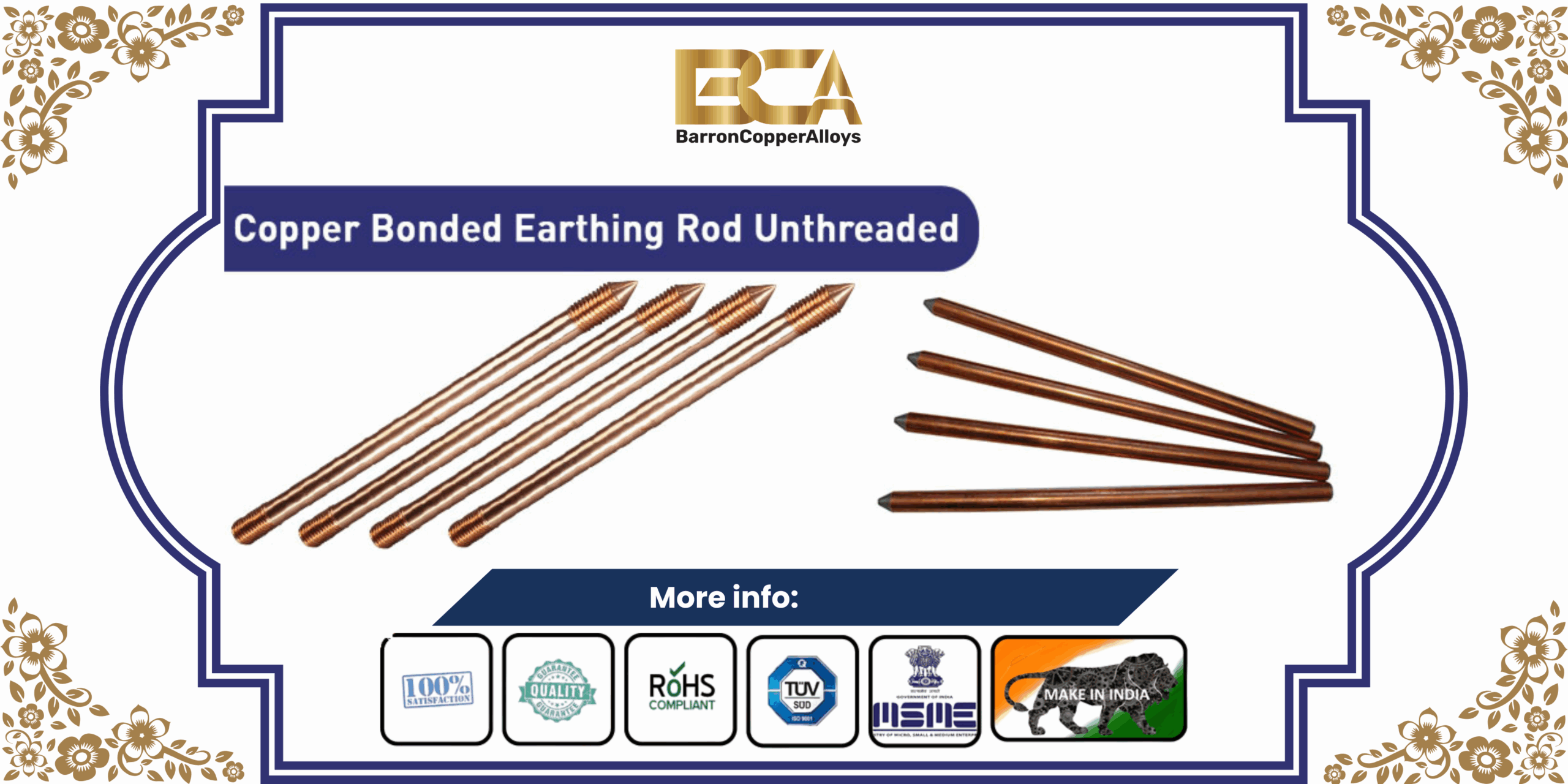Copper Bonded Earthing Rods Unthreaded
- Home
- Copper Bonded Earthing Rod Unthreaded

Copper Bonded Earthing Rods Unthreaded– Overview
A Copper Bonded Earthing Rods Unthreaded is a solid steel core electrode with a permanent molecularly bonded copper coating, designed to provide a low-resistance path to earth in grounding and lightning protection systems. Unlike threaded rods, the unthreaded type has a smooth surface, making it ideal for applications where couplers are not required, or a single-length rod is sufficient.
copper bonded earthing rod unthreaded, smooth copper earth rod, unthreaded grounding rod, copper coated earth electrode, electrolytic copper bonded rod, high conductivity earthing rod, corrosion resistant copper rod, IEC 62561 earthing rod, UL 467 grounding rod, solid copper bonded earth rod, electrical earthing electrode, lightning protection copper rod, steel core copper bonded rod, unthreaded copper grounding electrode, industrial earthing rod
Key Features
-
Material: High tensile strength low-carbon steel core.
-
Copper Bonding: Electrolytic copper molecularly bonded to steel (thickness typically 250–300 microns).
-
Design: Smooth, unthreaded surface with a pointed driving end.
-
Function: Dissipates fault current or lightning surge safely into the ground.
-
Corrosion Resistance: Copper coating resists rust and extends service life.
Common Applications
-
Electrical Earthing – Domestic, commercial, and industrial installations.
-
Lightning Protection Systems – As grounding electrodes for down conductors.
-
Telecommunication Towers – Prevents equipment damage from voltage surges.
-
Renewable Energy Systems – Solar and wind farm grounding.
Technical Specifications
| Parameter | Specification |
|---|---|
| Core Material | Low-carbon high-tensile steel (minimum tensile strength 600 N/mm²) |
| Copper Coating | 99.9% pure electrolytic copper molecularly bonded to steel |
| Copper Thickness | 250–300 microns (as per IEC & UL requirements) |
| Diameter Options | 12 mm, 14 mm, 16 mm, 20 mm |
| Length Options | 1.2 m, 1.5 m, 2.0 m, 2.4 m, 3.0 m |
| Design Type | Unthreaded, smooth surface with pointed driving end |
| Driving End | Cone-shaped or chamfered tip for easy soil penetration |
| Electrical Conductivity | ≥ 97% IACS (International Annealed Copper Standard) |
| Corrosion Resistance | High – suitable for all soil conditions including high moisture and salinity |
| Mechanical Strength | High bending and impact resistance |
| Standards Compliance | IEC 62561-2, BS EN 50164-2, UL 467 |
| Applications | Electrical earthing, lightning protection, telecom grounding, renewable energy grounding |
Variants of Clamp Cross Clamp
-
Solid Single-Length Rods – For standard installations.
-
Heavy-Duty Copper Bonding – Thicker copper layer for aggressive soil environments.
-
Special Tip Designs – Hardened steel tips for rocky terrain.
Copper Bonded Earthing Rod (Unthreaded) – Installation Guide
1. Tools & Materials Required
-
Copper Bonded Earthing Rod (Unthreaded)
-
Driving head / driving stud (to protect rod tip during installation)
-
Sledgehammer or mechanical rod driver (jackhammer with adaptor)
-
Earth conductor and approved earthing clamp
-
Measuring tape
-
Earth resistance tester
-
PPE (safety helmet, gloves, boots, eye protection)
2. Site Preparation
-
Location Selection – Choose a location away from underground services, fuel lines, and building foundations.
-
Soil Check – Prefer moist soil for better conductivity; avoid rocky, dry areas unless necessary.
-
Mark Installation Point – Clearly mark the spot where the rod will be driven.
3. Installation Procedure
-
Position the Rod – Place the rod vertically over the chosen spot.
-
Attach Driving Head – Fit the driving head onto the top of the rod to prevent mushrooming or deformation during hammering.
-
Drive the Rod –
-
Manual Method: Strike the driving head with a sledgehammer until the rod is fully driven.
-
Mechanical Method: Use a powered rod driver for faster penetration in hard soils.
-
-
Achieve Target Depth – Drive the rod to the required depth (commonly 2–3 meters) or until desired resistance is achieved.
-
Remove Driving Head – Once at depth, remove the driving head carefully.
4. Electrical Connection
-
Clean Rod Surface – Remove any dirt or debris from the rod where the clamp will be fitted.
-
Attach Earthing Clamp – Use a copper or bimetallic clamp to connect the earth conductor to the rod securely.
-
Tighten Connection – Ensure firm mechanical grip and good electrical contact.
5. Testing
-
Measure earth resistance using a 3-point or 4-point earth tester.
-
Target resistance should be within local standards (often < 1–5 ohms).
-
Record test results for compliance documentation.
6. Safety Notes
-
Always confirm there are no buried utilities before driving.
-
Use PPE to avoid injuries from flying debris or vibration.
-
In rocky terrain, pre-drill a pilot hole if necessary.
Advantages
-
High corrosion resistance and long service life.
-
Superior conductivity due to copper surface.
-
Strong steel core allows deep driving without bending.
-
No threads — ideal for single-section installations and cost efficiency.
Other Information
✔️ Sample Time: Available in 5-10 days for different items.
✔️ Drawing Format: CAD / PDF / DWG / IGS / STEP.
✔️ Packaging: Standard package, Carton box or Pallet, As per customized specifications
✔️ Shipping: DHL, FEDEX, UPS and By Sea or as per client’s requirements.

